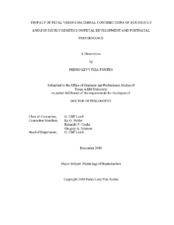| dc.description.abstract | The present research focused on examining how energy restriction, fetal and maternal subspecies (Bos taurus indicus and Bos taurus taurus) interact to impact fetal development events, which can potentially alter nutrient utilization and efficiency of offspring in cattle. A reciprocal embryo transfer approach (n=134) was used in a completely randomized design with a 2×2×2 factorial arrangement of treatments in order to generate 55 pregnancies over 2 consecutive years. Recipient cows were randomly assigned to: 1) a diet that met daily energy maintenance requirements (MAINT); or 2) a diet that restricted intake to 70% of requirements (RESTR). Angus (AN; Bos taurus) and Brangus (BN; B. indicus) embryo donors were superovulated and artificially inseminated with female sexed-sorted semen from the same breed. Embryos were then transferred to either AN or BN recipients fed their respective diets for 28 d. Recipients remained on the dietary scheme until d 91 of gestation. In utero female offspring development, postnatal growth, feed efficiency and puberty attainment were assessed.
The main findings included greater pregnancy failure by d 28 of gestation in AN recipient (recipient breed×diet, P<0.01) and embryos (embryo breed × diet; P=0.03) when cows were exposed to the RESTR diet. Brangus cows had smaller (<0.05) fetuses than AN, regardless of the breed of the embryo. Moreover, profile of circulating pregnancy associated glycoproteins differed during early gestation depending on the breed of the embryo (P<0.05), but not the breed or diet of the recipient (P>0.10).
Analysis of the metabolic profile of the recipients during early gestation energy restriction corroborates with the differences in pregnancy failure. Angus×RESTR cows had greater body weight loss (P<0.05), and lower circulating concentrations of IGF-1 (P<0.05) and insulin (P<0.05) than AN×MAINT, whereas BN×MAINT and BN×RESTR did not differ (P>0.10). Maternal diet or breed did not influence any postnatal response variables (P>0.10). Instead, AN heifers were more feed efficient (P<0.05), and achieved puberty earlier than BN heifers (P<0.05).
In conclusion, pregnancy establishment and early fetal development was influenced by diet, maternal and fetal subspecies. However, maternal subspecies and diet did not alter postnatal growth and performance in the female offspring. | en |


